Since Val, WD8KVD, had moved to Duluth, MN, for postdoctoral work with the EPA two years ago, we have spent a couple of weeks these past two summers visiting her. The Duluth area is fantastic for its natural beauty, and also for the people (many with Scandinavian roots) and their interest in outdoor activities. There are wide paved shoulders on many of the roads for bikers and in-line skaters (some people even go to work by these modes of transportation), and the most common summer auto accessory is said to be the canoe. You can visit a city park inside Duluth that looks and feels just like you're in the mountains. Get inside it 100 meters, and the city just doesn't seem to exist. Then there are the string of parks up the North Shore of Lake Superior, there because of the geology - not only from the legacy of the glaciers, but also of the long-gone mountains and the continental rift that started and then failed long, long ago. 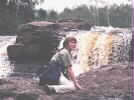 So Duluth is a wonderful place to visit in the summer (tho I'm not too sure how the winters would be, unless you're into dog sled racing. See the other write-up on Val and HSCW for a photo from their big race). And don't forget - their governor can beat up your governor! It's going to be interesting to see how an ex-SEAL, ex-pro wrestler holds up in the combat of the political arena!
So Duluth is a wonderful place to visit in the summer (tho I'm not too sure how the winters would be, unless you're into dog sled racing. See the other write-up on Val and HSCW for a photo from their big race). And don't forget - their governor can beat up your governor! It's going to be interesting to see how an ex-SEAL, ex-pro wrestler holds up in the combat of the political arena!
We knew from experience that EN36 was not a common grid on 144 MHz, and had wished that we could operate some HSCW meteor scatter from there. We didn't have anything capable of operating portable, and all Val had was an old 2-meter FM rig and a pair of ancient HT's . But when we recently found a used Gateway 2000 Solo 5100 laptop computer with an ESS audio chip, it began to look possible. We had a 150-watt solid-state driver, a 40-Amp switching power supply, and an IC-706 HF/VHF rig. We also had a 24-foot telescoping aluminum paint pole that had been used as a portable mast for emergency work while we lived in Michigan. If we could get it all together, this (1999) would be the year. So in April we began our plans to be sure that we had plenty of time.
On May 15, the XYL Lora's mother suffered a stroke while visiting her other daughter in northern Indiana. Lora was gone about a month to Indiana and Michigan helping her, leaving me at a busy time of year with an extra amount of work to do. Our son Steve and his family were to meet us at Val's, and Val had a canoe camping trip scheduled for all of us. That date could not be changed. This meant digging out and taking a lot of extra supplies. So when time came to leave for Minnesota, I had never had the entire system hooked together, and the antenna had not been used on the air. Also, since Val had recently moved about 10 miles north of the city of Duluth, we suddenly realized that she was no longer in EN36 but now lived in EN46. It was expected that this grid would be needed even more than EN36, so the Explorer was loaded (heavily) for the trip.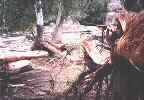
We left on July 6, with two days of beautiful driving weather, except for a small but severe thunderstorm at Indianapolis with 30 minutes of frog-strangling rain and much cloud-to-ground lightning. But at Duluth on July 8, it was raining again. Hard. And it continued for over 36 hours. Prior to this, on the previous Sunday, a "100-year-storm" had gone through the Boundary Waters Canoe Wilderness Area, flooding it and downing a large number of trees. This resulted in several injuries to campers from falling trees, with one death in Wisconsin.  And now it was raining again - heavily and continuously. We weren't even sure if the roads were open to that area. This new rain was causing major flooding just south of Duluth. In spite of the rain, we erected the 11-element KLM Yagi.
And now it was raining again - heavily and continuously. We weren't even sure if the roads were open to that area. This new rain was causing major flooding just south of Duluth. In spite of the rain, we erected the 11-element KLM Yagi.
We were supposed to leave on July 9 for the weekend of camping, canoeing, fishing, and enjoying the beauties of northern Minnesota. When I looked out the window that morning in preparation for my first HSCW MS sked, I couldn't even see the tree outside the window because of the rain and fog! Phone calls to the proper agencies indicated that the roads were open. But the portages might be "difficult" due to downed trees, and we would have to plan to clear our campsite of several layers of fallen trees! 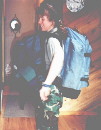 Actually, the authorities weren't really sure about all this, as they had not had time to do more than a fly-over inspection of some of the area. Lora had previously twisted a knee playing soccer with our grandson, and, with all of this rain, the trip just wasn't as appealing as it had been! So Lora and I volunteered to take care of Val's cats and Steve's dogs while the rest of the family went on their expedition. This would also give me time for more HSCW MS skeds, as a number of the stations were rather distant for an 11-element Yagi only 18 feet above the ground. (When the intrepid explorers returned Sunday evening, they reported that conditions were much worse than expected. The one planned portage was impassable, they had to try 3 campsites before finding a usable one, and they could get to only one lake in the time available, but where the fish weren't biting. The weather cleared up, but the clouds of mosquitoes kept a constant dark cloud around them. Mosquito repellent was useless, and they even had to eat their meals while wearing head nets).
Actually, the authorities weren't really sure about all this, as they had not had time to do more than a fly-over inspection of some of the area. Lora had previously twisted a knee playing soccer with our grandson, and, with all of this rain, the trip just wasn't as appealing as it had been! So Lora and I volunteered to take care of Val's cats and Steve's dogs while the rest of the family went on their expedition. This would also give me time for more HSCW MS skeds, as a number of the stations were rather distant for an 11-element Yagi only 18 feet above the ground. (When the intrepid explorers returned Sunday evening, they reported that conditions were much worse than expected. The one planned portage was impassable, they had to try 3 campsites before finding a usable one, and they could get to only one lake in the time available, but where the fish weren't biting. The weather cleared up, but the clouds of mosquitoes kept a constant dark cloud around them. Mosquito repellent was useless, and they even had to eat their meals while wearing head nets).
We had set up the rig in an upstairs room on the table with Val's computer. We could look out the window into the forest of the north woods, for this is some 10 miles out in the country. Every morning by 5:00 a.m. local time a phoebe would sit on the chimney of the barn and start calling his buzzy call (we didn't need an alarm clock). The chorus would soon be joined by the rising crescendo of an oven bird or the descending multi-note spiral of a veery, while a white-throated sparrow reminded us all day long that we were only a short distance south of "pure sweet Canada, Canada, Canada."  The local bear did not appear during our stay, and we did not hear the wolves that roam a few miles up the road. Other quadrupeds were often seen, however. If it hadn't been for the mosquitoes and black flies that continually came for their donations to the blood bank, the following week's cool rainless days would have been ideal.
The local bear did not appear during our stay, and we did not hear the wolves that roam a few miles up the road. Other quadrupeds were often seen, however. If it hadn't been for the mosquitoes and black flies that continually came for their donations to the blood bank, the following week's cool rainless days would have been ideal.
However, that first morning (July 9), with the rain still falling, we ran the first sked with W1FIG (FN41), normally very strong when back in KY. We heard only 3 possible pings (he heard 1 S1). But the SWR, which had been near unity, was now very high. Apparently our attempts at a temporary waterproofing of the antenna's feed had been insufficient in the strong and gusty winds. Things were not looking good!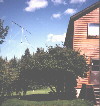
The next schedule was with K0XP (FN42), with whom we normally run a 15-minute schedule 5 days per week, with a completion rate of about 80%. But that is from KY, from a location that is somewhat poorer than Val's in MN; but there I have the EME-capable 8877 amp and quad Yagi array available! On this schedule we heard nothing. Neither did K0XP, so he told K2TXB (FM29), the next on the list, to start calling early. I suddenly began to get 2-4 short, very weak pings each calling period. It took only 2 periods to be sure that it was K2TXB calling me. His signals, while very frequent, were short (about 1/2 second) and very weak for Russ - so weak that only two or three even showed up on the WinMSDSP 2000's screen! But most were readable, and all were just about the same length and strength. It required 45 minutes, but my first-ever portable HSCW QSO was complete. (All skeds were run on 144.110 ZB, 6000 or 8000 lpm). Click here for ping from K2TXB (5 K long).
Later that day the rain finally stopped and the wind began to dry out the antenna. After a few hours of this, the SWR was back to normal. A slow-speed CW tropo sked was made with W0PHD for that evening, as he needed the grid and was too close for MS. This was accomplished easily, and another station near him, N0SRQ, then called in, requesting the grid.
The next morning, July 10, HSCW MS skeds were begun in earnest. Unfortunately, the antenna was low (about 18' above ground) and the distance to most of them was over 1000 miles. The sked with W1FIG produced 3 weak S2 pings, each with several sets of calls; but he received only a single S1. K0XP was heard on only 2 weak pings with no complete calls. We then ran downstairs, pulled up the tent peg holding the antenna's anchor string and aimed toward VE5UF (DO61). This was to be our first MS sked at a near optimum distance. Sure enough, Doug came through with about 15 weak S2's and QSO number 2. Click here to hear ping from VE5UF, 6 K long.
Following another CQ, the next sked was with N0KQY (DM98), also in the optimum MS range. Gary had several S1's but only 4 S2's. He was sending his grid for a report, and we copied it 3 times. But we never could get his call. Dashes eat up a lot of time! So we moved the antenna back slightly toward K7YVZ (DN13), our most distant sked. Nil.
That evening we set up for a pair of quick pick-up skeds with K0GU and W5HUQ. K0GU had to re-cable for HSCW and found that he could not get things to work correctly, so we called CQ that general direction for an hour. W5HUQ was too far south for the limited azimuth capabilities of the beam, but we ran the evening sked, offsetting to the west, anyway. 2 S2's gave us complete calls, but he received only 1 S1. It was decided to wait on him until we later repositioned the antenna in order to also run with WB5APD (EM84).
On the morning of July 11 we ran with only 3 stations. N1RWY (FN54) had 2 S1's and 4 S2's with complete calls but no report. K0XP was not heard at all. Then N0KQY (DM98) kept us busy with about 26 S1's and 21 S2's. It required the full half hour due to all of the dashes, and Gary's transmit speed suddenly slowed somewhat in the middle of the schedule. But a third HSCW MS QSO was now in the log.
The schedules on the morning of July 12 produced very little. Interestingly, the best signal received was from K7YVZ, who was also our most distant station, when we received complete calls. That evening we picked up a schedule with WB1FLD (FN42). A fair number of pings were received, and the contact was completed right at the end of the schedule for the fourth HSCWS MS QSO of the trip. (Click here for ping on W8WN - note, 14 K long file).
On July 13, Val, WD8KVD, was able to be here and operate a couple of morning schedules. K0XP produced only 2 weak S1's. K2TXB was heard nearly every period. However, he was not copying as much from us, and the contact was not completed.
We were doing fair, but not making as many contacts as had been hoped. The antenna was low and the location was not great for VHF. So Val and I decided to take the show on the road and go portable the next morning. The road climbed about 50 meters to a good hilltop only about one km to the east, and permission was secured to erect the antenna in the edge of a hayfield. It looked like a great location - if the power lines across the road were quiet, and the weather cooperated.
By 5:00 a.m. local time (1000 UTC) the next morning (July 14) the Explorer had been pulled into the weeds beside the road and the antenna was being erected. This took longer than expected due to the clouds of mosquitoes that covered us. Mosquito repellent didn't seem to bother the bloodthirsty little vampires at all, and they remained a problem all morning. We wished for some tiny harnesses - we could have raised the antenna another 15 meters if we could have harnessed all that wing power! Val's generator had produced too much ignition interference, so the operation was powered by the Explorer.
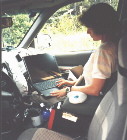 Because of the mosquitoes and the threat of bad weather, all operation was from inside the vehicle. There was enough room, but it was crowded and difficult for both of us to see the computer screen. Val had requested better definition on the laptop's screen, which shrank the already-small WinMSDSP 2000 screen even smaller. This, plus the general difficulties of operating in this manner, were to contribute to a problem later that morning. But now it was 1100 UTC and time for the first schedule, running under Val's call, WD8KVD.
Because of the mosquitoes and the threat of bad weather, all operation was from inside the vehicle. There was enough room, but it was crowded and difficult for both of us to see the computer screen. Val had requested better definition on the laptop's screen, which shrank the already-small WinMSDSP 2000 screen even smaller. This, plus the general difficulties of operating in this manner, were to contribute to a problem later that morning. But now it was 1100 UTC and time for the first schedule, running under Val's call, WD8KVD.
K7YVZ, first on the list, was poor, with 1 S1 and 1 S2. He later reported that he didnít hear us even that well. W1FIG was heard quickly, giving us both calls. But then, somehow, we began transmitting on the wrong sequence! Val was handling the computer; and as she runs HSCW for only a few schedules once per year, she didn't realize that she should be watching for this type of error. As the computer screen was difficult for me to see, I didn't catch it for awhile. How long we were on the wrong sequence, when we changed, and what caused the switch is unknown. After we realized the problem and changed, we still heard nothing else. So whether or not we could have completed the contact is unknown, but doubtful due to conditions that morning.
Following the sked with W1FIG, there was a short open period, and CQ was called to the east. K2TXB immediately replied with ping after ping. But our signals to him had dropped off about the time he began calling us, and he never received his call or report. Why he had heard us well for a few minutes, then almost quit hearing us while we heard so many pings from him, remains a mystery.
K0XP was unable to meet his schedule, so the next was with WD5APD. This would be our one easy schedule. And on the very first period he came through with both calls. But for the next 50 minutes we got ping after ping after ping, as many as 6-8 pings per period. But all were too weak and too short to contain more than a part of a letter! This was not only frustrating, but was becoming unbelievable! Finally, 52 minutes into the hour-long sked, part of the calls and a 27 report were received. Since he didnít have our report yet, we switched to R26. And on his last transmit period we received a string of R's. The first QSO of the morning, the first this year for WD8KVD, and the 5th MS QSO of the trip, was in the log! But what a task to get it! This good location just wasn't helping that much. (Actually, it appeared that the location was fine - just that the meteors weren't cooperating).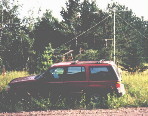
One more schedule remained, with W5HUQ. This was expected to be an easy one. Wrong again! We received several S1's and 2 S2's. And once again we were on the wrong sequence for part of the schedule. As before, we are not sure just what happened. But the pings were few, and we apparently were not on the wrong sequence very long, so we doubt that the contact could have been completed anyway.
It was now noon, the sky had cleared up, and the sun was beating down on us. Time to pull down the antenna, eat dinner, and wash off some of the bug dope. The radio equipment was unloaded and hooked back up in the house, and the antenna was moved to the west side of the house in an attempt to work the stations in the south who had been patiently waiting.
That evening a quick schedule was set up with W5HUQ. But we were late getting home, and had to start the schedule slightly late. Since we had heard very little from him that morning from a good location, why would an evening sked, with the antenna now lower and looking into a tree, do any good? Surprise, surprise! The late-starting schedule produced HSCW MS QSO #6!
W5SNX (EM73) had requested a schedule now that the antenna could be aimed in his direction. On July 15 reports were exchanged, but not the R's, so it was not complete. That evening (Thursday) another attempt was made with approximately the same results. K7YVZ produced only a few pings and one set of calls on his sked. We ran with both stations again on Friday morning (July 16). Once again, only a few pings were heard on W5SNX, even though again reports were exchanged. K7YVZ was heard with 2 S1's and 3 S2's, but again no report was received from him. Click here for ping from K7YVZ, 5 K long.
Time was running out, as the antenna would have to be disassembled Saturday, so there was time for only two more sets of skeds. Then it was discovered that the telephone lines were dead, most likely because of the recent flooding. We reported the outage using the cell phone and were told that it would be the first of the week before they were restored. Schedule times had not been sent out, we couldn't get on line, and did not have any databases with phone numbers! Finally, the phone number of WB1FLD was found, but no one was available. A message was left on his answering device, not knowing if he would get it in time or not since it was now mid afternoon Friday (he did, and relayed the message). A quick CQ on 144.200 then raised KA0PQW. Matt did not have Internet access, but he phoned KB0PYO who did. Mark also immediately put the sked times on the Internet. Meanwhile, several other "locals" called in wanting our grid. They said that even for them, EN46 was quite rare, so several more SSB contacts were made.
After supper (local evening of July 16, or July 17 UTC) I started to put out a SSB CQ to see if there were still others in the general area who needed this grid. But the IC-706 went crazy! The watt meter was registering full power with no modulation on SSB. On CW, with the key up, it was also showing full power out! It wasn't from the amplifier or from RF getting back into the rig, as first suspected. Nothing wrong could be found, and it was impossible now to cancel the upcoming skeds. The Icom was turned off for a half hour, then tested again at sked time. It would work correctly part of the time. By running at reduced power (about 100-125 watts out) and monitoring the keying with the HT, it seemed to put our a proper signal for the Friday evening schedule with K7YVZ. However, not a ping was to be heard from him. As we didn't have a telephone and could not check E-mail, it wasn't known if he had even been able to meet the schedule.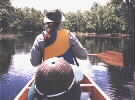
W5SNX was on his schedule, and surprised us with calls and a report, nearly 5 seconds long, in the first half of the sked. Several very weak R's were heard just before the end, almost too weak to copy. Other than a few weak S1 pings, that was all we received. But they were enough, and MS QSO number 7 was in the log! The Icom was working, driving the amp to full power; however, it was threatening to go wild at the start of every transmission. It did not seem to be a heat problem, but was showing signs of being a cold solder joint. (At this time we still don't know what happened).
The next morning we had set up schedules with K7YVZ and W5SNX via our "Internet Relay System." NJ0M called in to say that K7YVZ couldn't meet the schedule, so we called another CQ, with no replies. This ended the HSCW meteor scatter operating from EN46 at the QTH of WD8KVD. The final result was 7 MS QSO's with 7 stations, with the other 4 being heard, several with good (but infrequent) pings. All stations under 1000 miles were worked. Two other stations had requested skeds but were unable to be on. 14 stations were worked on tropo; and even though most were rather close, we were able to provide a new grid for many of them. We worked only Dick, K0MQS, on 144 MHz (SSB) while mobile, and only 4 stations on 50 MHz mobile. We worked 7 grids via MS, 7 via tropo, (plus 1 on 144 MHz mobile and 4 on 50 MHz mobile). We apparently had both extended tropo and a little Es on 144 MHz while mobile on the way up. We could hear weak signals in the background and heard locals working a couple of stations on the SE coast. But with the little turnstile for 2 and a helical whip for 50, we really couldn't tell for sure what was happening, as it wasn't good enough for us to get into it.
Arriving back in central KY (EN77) on the evening of July 20, we found that we couldn't even check the E-mail due to a cut fiber-optic cable causing an outage for most of the ISP's in the area! Ah, the wonders of modern technology!
Whether or not we can do this type of operation this time next year, or at all, is uncertain. Val's postdoctoral work ends in less than a year, and it isn't known if she will be able to remain in the Duluth area (though she intends to). Our son may not be able to take his vacation at the same time since General Bullmoose (er, General Motors) has sold Delphi (formerly AC); but nothing will be known until after the next contract fight. The antenna was just too small and too low to be effective, but going higher and larger would be difficult. So the future will have to remain uncertain. But it was fun, and interesting to be on the "desired grid" end, and on the portable end, running the low power and small antenna, for a change!  Thanks again for those who assisted, for those with the patience to run several skeds, and for all the encouragement from both those running skeds and those out of range on the sidelines. Your support was greatly appreciated!
Thanks again for those who assisted, for those with the patience to run several skeds, and for all the encouragement from both those running skeds and those out of range on the sidelines. Your support was greatly appreciated!
Shelby, W8WN - Val, WD8KVD - Lora, WD8LPN
Go to the W8WN HSCW Home Page
Home (Index) page
Read about WD8KVD's record-setting HSCW contacts
1999 July 23
 So Duluth is a wonderful place to visit in the summer (tho I'm not too sure how the winters would be, unless you're into dog sled racing. See the other write-up on Val and HSCW for a photo from their big race). And don't forget - their governor can beat up your governor! It's going to be interesting to see how an ex-SEAL, ex-pro wrestler holds up in the combat of the political arena!
So Duluth is a wonderful place to visit in the summer (tho I'm not too sure how the winters would be, unless you're into dog sled racing. See the other write-up on Val and HSCW for a photo from their big race). And don't forget - their governor can beat up your governor! It's going to be interesting to see how an ex-SEAL, ex-pro wrestler holds up in the combat of the political arena!










